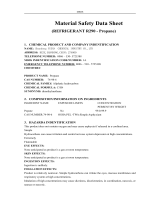
_________________________________________________________________________________________________
Date: November 12, 2012 KLEA®134a
Revision 4 Page 6 of 7
No effect of any kind was seen in a 90-day inhalation study in the rat at dose levels up to, and
including 50,000 ppm (6 hours per day, 5 days per week).
No developmental effects were seen in the rabbit following inhalation exposure to 40,000 ppm
during gestation despite slight maternal toxicity. In a range-finding study in the rabbit, possible
minimal embryo lethality was seen at a dose level of 50,000 ppm. In the rat, slight fetotoxicity
was present at an inhalation dose of 50,000 ppm administered during gestation and no effects
were seen at 10,000 ppm. In another study in the rat, no developmental effects were seen at a
dose of 100,000 ppm in the presence of slight maternal toxicity; clear maternal effects were
followed by embryo toxicity and fetotoxicity at a dose level of 300,000 ppm. There were no
increases in the incidence of fetal malformations in rats or rabbits at doses up to and including
300,000 ppm and 50,000 ppm, respectively.
HFC-134a showed no genetic toxicity in a range of in-vitro and in-vivo tests. No adverse effects
were found in a study in which rats were followed to week 104 after receiving 300 mg/kg
bodyweight/day of HFC-134a by gavage for 52 weeks. In a 2-year inhalation study in rats, no
adverse effects of any kind were observed except increased incidences of non-life threatening,
benign, microscopic testicular interstitial (Leydig) cell tumors and associated interstitial cell
hyperplasia which were confined to the top dose of 50,000 ppm.
12. ECOLOGICAL INFORMATION
Ecotoxicological Information: Daphnia 48 hour EC50: 980 mg/l. Rainbow trout 96 hour LC50:
450 mg/l.
Persistence and Degradation: Decomposes comparatively rapidly in the lower atmosphere
(troposphere). Atmospheric lifetime is 14 years. Products of decomposition will be highly
dispersed and hence will have a very low concentration. It is not a significant contributor to
photochemical smog and is not considered to be a VOC. Is not considered an ozone-depleting
chemical.
Effect on Effluent Treatment: Discharges of the product will enter the atmosphere and will not
result in long-term aqueous contamination.
13. DISPOSAL CONSIDERATIONS
Disposal Method: Discarded product is not a hazardous waste under RCRA, 40 CFR 261.
However, HFC-134a should be recycled, reclaimed, or destroyed whenever possible.
Container Disposal: For disposable (DOT 39) cylinders only. Do not distribute, make available,
furnish, or reuse container when emptied of the original product. Open valve to remove pressure
in the cylinder. Then puncture, drill, crush, or otherwise destroy empty cylinder and dispose of in
a facility permitted for nonhazardous waste. Return all other containers to supplier.
Refrigeration Application: Subject to "no venting" regulations of Sections 608 and 609 of the
Clean Air Act during the service or disposal of equipment.











